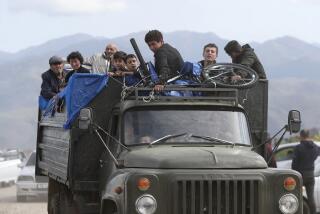New Ethnic Fighting Erupts in Soviet Armenia : Moscow Reports 16 Hurt in Weekend Clashes; Dissident Puts Toll at 12 Dead
- Share via
MOSCOW — New clashes were reported Monday between Armenians and Azerbaijanis in the troubled southern Soviet republic of Armenia, despite government efforts to calm the ethnic tensions there.
The government said that 16 people, half of them Armenians and half Azerbaijanis, were seriously injured in weekend fighting in Masis, a town of 10,000 people just southwest of Yerevan, the Armenian capital. The fighting started when gangs of Armenian youths allegedly attacked local Azerbaijani residents.
A dissident Soviet journalist returning from Yerevan reported a higher toll, however. He said that 12 persons, six Armenians and six Azerbaijanis, were killed in the clashes, which began late Friday and apparently continued at least through Sunday.
The journalist said his information, from Armenian sources, was that an Azerbaijani had driven into Masis and fired shots into the air. The Azerbaijani was attacked by local Armenian residents, according to this version, and returned later with friends to avenge himself.
By both accounts, groups of Armenians and Azerbaijanis seemed determined to do battle, apparently marking an escalation in the crisis between Armenia and the neighboring Soviet republic of Azerbaijan.
Troops on Patrol
Troops in armored cars were reported patrolling Masis on Monday to prevent further clashes. Troops are still patrolling Baku, the Azerbaijani capital, and other cities in that republic to prevent further violence.
Grant M. Voskanyan, the Armenian president, denied widespread reports that people had been killed, but he appealed for calm in a special broadcast on Yerevan radio.
“The responsible bodies are taking strict and decisive measures to return order and normalize life in the district,” Voskanyan said. “Investigations are being carried out, and the culprits will be punished severely. . . .”
He added:”I appeal to the Armenian and Azerbaijani populations of the republic to display self-restraint and healthy judgment. I ask them not to express unnecessary emotions and feelings and not to listen to those who are spreading ethnic mistrust and discord.”
The conflict, in which a total of 35 people, most of them Armenians, have been killed, began early this year with a demand by the Armenian residents of Nagorno-Karabakh, a region in the Soviet republic of Azerbaijan, that it be transferred to neighboring Armenia. Azerbaijan rejected the request again last week.
The conflict is the latest chapter in a centuries-old rivalry that the Soviet Union had boasted it had solved fully, thus demonstrating the superiority of socialism in its ability to achieve a political resolution of such difficult and sensitive problems.
Armenians--Christians whose faith dates back to the 4th Century--strongly resent being ruled by the Azerbaijanis, Turkic-speaking Muslims they hold responsible for the Turkish massacre of Armenians in 1915.
The killing of 32 people, most of them Armenians, in the Azerbaijani city of Sumgait in late February has been officially described here as a pogrom against Armenians as an ethnic group, even a political-economic class.
Azerbaijanis, who see themselves as members of a rapidly growing Islamic nation that stretches within the Soviet Union from the borders of Turkey and Iran across Central Asia, have rallied to the cry, “Where the green flag (of Islam) has flown, no land will be lost, no betrayal permitted.”
The issue will now be put to the central government, with either the national Parliament or the Supreme Court making a decision. But the real debates will take place in the Communist Party’s Central Committee, which will have to weigh conflicting constitutional claims of national self-determination against the inviolability of the country’s frontiers, even its internal borders.
Soviet sources have suggested that this re-examination of all the issues involved will be prolonged, in order to allow the crisis to cool and ease the search for a compromise. But further violence may make that ambition difficult to achieve.
Voskanyan, the Armenian president, blamed the fighting at Masis on “a group of irresponsible youths” apparently angered by the Azerbaijani Parliament’s decision Friday to refuse to cede Nagorno-Karabakh to Armenia. He said the youths went to Masis “to incite certain Armenian inhabitants of the region into acts of hooliganism.”
The other account, involving a gun-wielding Azerbaijani, was provided by Andrei Shilkov, a member of the dissident journal Glasnost, which takes its name from the government’s pledge of political openness.
Shilkov, quoting Armenians he talked with in Yerevan over the weekend, said:”The fighting was apparently very tough and went on and on and on. . . . The casualties may well be more than the 12 dead we heard about.”
Further fighting was reported at the village of Sayat Nova, also apparently touched off by the Azerbaijani refusal to give Armenia administrative responsibility for Nagorno-Karabakh’s 184,000 residents, three-quarters of whom are Armenian.
Editor Confirms Deaths
Sergei I. Grigoryants, the editor of Glasnost, whose reports on the Armenian-Azerbaijani conflict over Nagorno-Karabakh have generally proved to be correct, said he had confirmed the deaths at Masis from other sources in Yerevan.
Grigoryants showed foreign correspondents, who are barred from the region, a video film made late last week in Baku and Yerevan showing Soviet troops in armored cars guarding the two Armenian quarters of the city.
Shilkov said he expects more serious trouble. “The situation in Baku and Azerbaijan particularly is significantly more serious now than on our last visit in March,” Shilkov said. “There is a real atmosphere of fear in Baku, very unfriendly to Russians and really hostile to Armenians.”
More to Read
Sign up for Essential California
The most important California stories and recommendations in your inbox every morning.
You may occasionally receive promotional content from the Los Angeles Times.













